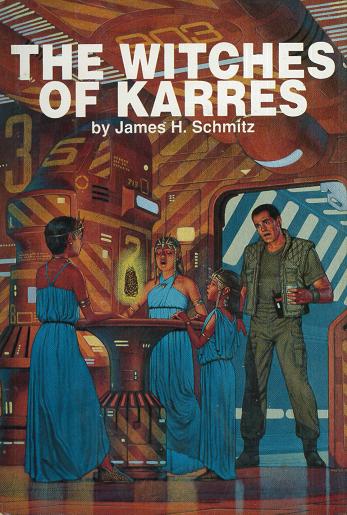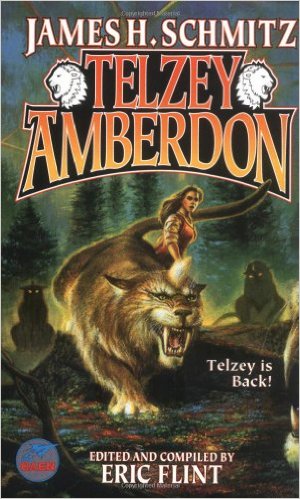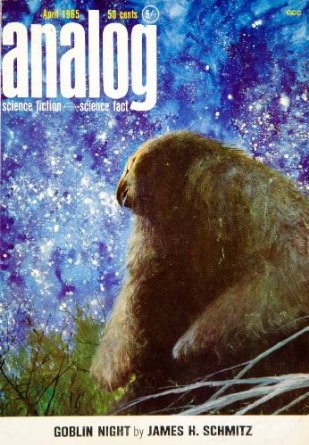In this monthly series reviewing classic science fiction books, Alan Brown will look at the front lines and frontiers of science fiction; books about soldiers and spacers, explorers and adventurers. Stories full of what Shakespeare used to refer to as “alarums and excursions”: battles, chases, clashes, and the stuff of excitement.
Science fiction opens a universe of possibilities for the author and the reader. New worlds, new creatures, and new civilizations can all be created to serve the story. And this broad canvas, in the right hands, can be used to paint stories of grand adventure: spaceships can roar through the cosmos, crewed by space pirates armed with ray guns, encountering strange beings. The term “space opera” was coined to describe this type of adventure story. Some authors writing in this sub-genre became lazy, and let their stories become as fanciful as the settings, but others were able to capture that sense of adventure and wonder, and still write stories that felt real, rooted in well-drawn characters and thoughtful backdrops.
One such author was James H. Schmitz. If you were reading Analog and Galaxy magazines in the 1960s and 70s, as I was, you were bound to encounter his work, and bound to remember it fondly.
Like many who earned their living from writing science fiction in the mid-20th Century, James Schmitz was prolific, creating many stories and many characters worthy of note—this creates a dilemma for the reviewer, as there are so many good works to choose from. So in this column, I have drawn from the example of multiple choice tests, and chosen the option “all of the above.” Instead of reviewing one work, I will be reviewing an anthology that collects some of Schmitz’s best stories; The Best of James H. Schmitz, published by NESFA Press, an organization that does great work issuing well-bound volumes by many classic SF authors. The book also has a beautiful cover by Kelly Freas, which also appeared on an issue of Analog, portraying the protagonist of the story “The Custodians.”
James Schmitz was born in Hamburg, Germany in 1911, but spent most of his life in the U.S., and served in the U.S. military in WWII as a photographer in the Army Air Corps. After the war, he moved to California and began writing fiction; he wrote steadily into the 1970s, and died in 1981. Like many writers of the time, he found a lucrative market in the genre magazines, and as a result, most of his body of work is in shorter lengths. Schmitz’s writing was well suited for short fiction: his prose crisp and direct, and his descriptions just long enough to let the reader fill out the details. He found a home in many of the science fiction magazines of the time, and was one of Analog editor John Campbell’s favorites. His work received numerous nominations for the Hugo and Nebula Awards, but never won. He was notable in that era for portraying female characters and people of color in roles that did not fit the stereotypes of the time—for example, his female characters were more likely to be the rescuer than to be rescued—and what caught my attention, as a young reader, was his frequent use of teenaged protagonists. While his stories take place in colorful settings with all sorts of spies, criminals, pirates, and police, the fantasy was always strongly rooted in characters that felt real and genuine.
 Schmitz’s most famous work is probably the humorous novelette “The Witches of Karres.” As was common with popular short works in the era, it was later expanded into a novel (which was nominated for, but did not win, the Hugo Award). The story involves a space captain who rescues three young witches from space pirates, only to find that it may have been the pirates that were the ones actually rescued. While some of Schmitz’s early stories took place in a Confederacy of Vega, the bulk of his work appeared in the Federation of the Hub, a star cluster that has largely forgotten Earth and the origins of mankind. The Hub was very loosely described, as Schmitz was not one to let background get in the way of telling the tale at hand.
Schmitz’s most famous work is probably the humorous novelette “The Witches of Karres.” As was common with popular short works in the era, it was later expanded into a novel (which was nominated for, but did not win, the Hugo Award). The story involves a space captain who rescues three young witches from space pirates, only to find that it may have been the pirates that were the ones actually rescued. While some of Schmitz’s early stories took place in a Confederacy of Vega, the bulk of his work appeared in the Federation of the Hub, a star cluster that has largely forgotten Earth and the origins of mankind. The Hub was very loosely described, as Schmitz was not one to let background get in the way of telling the tale at hand.
Perhaps the most popular stories of the Hub series featured the teenaged Telzey Amberdon, a young woman with telepathic, or psi, powers, who contends with not only a variety of villains and monsters, but also governmental agencies that have been set up to find and control telepaths. Telzey appeared frequently in Analog, as Campbell was at the time fixated on the idea that mankind might have untapped mental powers; other notable characters in the Hub series included special agents like Trigger Argee and Heslet Quillan. Rather than tell stories that dealt with revolution or change, Schmitz’s protagonists were often tasked with maintaining the status quo, a focus that was very in tune with the mood of post-WWII America. Schmitz generally set his work on Earth-like planets, although he could be quite inventive with the creatures that inhabited those worlds.
The Best of James H. Schmitz contains nine short stories and novelettes, offering a good cross section of Schmitz’s work:
“Grandpa” is a story told from the viewpoint of Cord, a 15-year-old boy who is part of a colonization team on a new planet. Like many children his age, he has become intimately familiar with the flora and fauna of his neighborhood, including Grandpa, a large mobile creature that resembles a giant lily pad. Adults who want to use Grandpa as transportation ignore Cord’s warnings that the creature is behaving oddly, and it is up to the boy to figure out what is wrong and rescue his elders. The only thing that dates this story is the lack of portable communications devices, something ubiquitous in our world, which would have allowed Cord to call for help (but would have also made the story much duller).
“Lion Loose…” is a fast-paced tale set in the Hub, where a gang of murderous space pirates use an alien creature with mysterious powers to take over a space-based hotel. It is up to the mysterious Heslet Quillan, a crook who is more than he appears, to foil their plot and rescue the inhabitants. This story is an example of Schmitz at his best, and was another Hugo nominee. This is also one of those few Schmitz stories that is dominated by men, and Quillan has a habit of calling his female compatriot “doll,” but other than that the story feels as fresh today as it did when it was written. The tale moves at a breakneck pace, as Quillan throws himself headlong into danger, bluffing his way into the midst of the pirate band.
“Just Curious” is set on Earth at an unspecified date, and could easily take place in the present. It involves a man who can temporarily inhabit the minds of others, and focuses on the advantages, and the dangers, that power creates.
“The Second Night of Summer” is one of my favorite Schmitz stories. It is set in the Vega series, and opens from the viewpoint of another young protagonist, Grimp. His village, in a quiet corner of the planet Norhut, has been visited by strange lights during the past few summers, and he eagerly awaits the arrival of Grandma Wannattel, a folk healer who travels in a wagon pulled by an alien pony who more closely resembles a rhinoceros. Unknown to the villagers, these lights are the first signs of an alien invasion from another dimension so dangerous that the space navy would destroy the entire planet rather than allow it to spread. And also unknown to the villagers, both the harmless-seeming Grandma and her intelligent pony are government agents entrusted with a mission that could save the planet. This situation is pure Schmitz, subverting many of the space opera tropes of his day—there are no brawny soldiers or naval vessels battling their way through their foes in this story. Instead, it is up to a post-menopausal woman of color, and her wits and skill, to save the day.
 “Novice” is the story of Telzey Amberdon’s awakening to her telepathic powers. Her aunt Halet has taken her on vacation from law school to the planet Jontarou, along with Telzey’s pet, Tick-Tock. Tick-Tock is a cat-like alien creature of unknown origin with extremely effective chameleon abilities. Telzey is uneasy on the planet, and having strange nightmares and visions. Her aunt has always been jealous of Telzey and her mother, and it turns out that this vacation is a trap: Tick-Tock is a member of a species called crest cats that appear to have gone extinct, and the aunt has contacted authorities that will confiscate the animal. In an explosion of newfound xenotelepathic powers, Telzey finds that she can communicate with the crest cats, who are anything but animals—racing to adapt to her new abilities, and using her legal education, Telzey must find a way to bridge the gap between the humans on the planet, and its native intelligent species. This story does a better job with most stories of its age in portraying personal communication devices, featuring wrist-borne communicators and law libraries with view screens that can fit into a pocket. In a theme common to many Schmitz stories, in “Novice” the protagonist has to rely on her intellect and training to find a solution to her problems.
“Novice” is the story of Telzey Amberdon’s awakening to her telepathic powers. Her aunt Halet has taken her on vacation from law school to the planet Jontarou, along with Telzey’s pet, Tick-Tock. Tick-Tock is a cat-like alien creature of unknown origin with extremely effective chameleon abilities. Telzey is uneasy on the planet, and having strange nightmares and visions. Her aunt has always been jealous of Telzey and her mother, and it turns out that this vacation is a trap: Tick-Tock is a member of a species called crest cats that appear to have gone extinct, and the aunt has contacted authorities that will confiscate the animal. In an explosion of newfound xenotelepathic powers, Telzey finds that she can communicate with the crest cats, who are anything but animals—racing to adapt to her new abilities, and using her legal education, Telzey must find a way to bridge the gap between the humans on the planet, and its native intelligent species. This story does a better job with most stories of its age in portraying personal communication devices, featuring wrist-borne communicators and law libraries with view screens that can fit into a pocket. In a theme common to many Schmitz stories, in “Novice” the protagonist has to rely on her intellect and training to find a solution to her problems.
“Balanced Ecology” is a Nebula-nominated story telling of a family that runs an extremely valuable diamondwood tree farm. The story is told from the viewpoint of the young boy Ilf, who lives on the farm with his sister Auris. The narrative follows their daily activities as they interact with a variety of strange creatures that live in the diamondwood forest, including the giant turtle-like creature who lives at its heart. A distant relative, who has joined forces with investors who want to clear-cut the forest, comes to visit with malicious intent. Eventually, the children find that the world they live in so peacefully is stranger than they ever imagined, and the story upends your original impressions in quite an exciting and unexpected conclusion.
“The Custodians” is another rip-snorting adventure story, in the same vein as “Lion Loose…” Harold Gage, a navigator on a tramp freighter, is returning to the Sol system, and his captain suggests stopping at an inhabited asteroid, allowing Harold to visit his sister Elisabeth. At this point in history, Earth has descended into a kind of feudal chaos, and the freighter is transporting a pair of aliens who are host to birdlike parasites with razor-sharp talons—aliens who will be selling their abilities to the highest bidder. The freighter has been on the edge of piracy for quite some time, with only Harold’s conscience standing between the crew and lawlessness—what Harold doesn’t know is that the captain wants to kill the people on the asteroid, including his sister and himself, and use it as a base of operations. Harold is forced to use his gun and his wits just to stay alive, and in a twist that reveals the meaning of the story’s title, the pirates find the asteroid is not the easy target they thought it was. This is one of those stories that I encountered in Analog at a young age and has stayed in my memory as a favorite to this day.
“Sour Note on Palayata” is another Hub story, and follows the young woman named Pilch, an agent of the Hub Psychological Service. She has been sent to the planet Palayata to assist Assistant Secretary Bayne Duffold, of the Hub System Outpost Department. The natives of the planet are behaving in a strange manner, and most humans find it extremely unpleasant to be in their presence; there are increasing fears that they may have telepathic powers that pose a threat to the stability of the Hub Federation. Pilch and Duffold must unravel the mystery in a way that protects both the Hub and the Palayatans. This is another story that unfolds like a puzzle, and shows how Schmitz is able to make even the workings of a massive bureaucracy interesting.
 “Goblin Night” is a memorable tale of Telzey Amberdon that originally appeared in Analog—it is another that has stuck in my mind for years, not just because of the story, but also because of John Schoenherr’s evocative cover painting of the eponymous goblin. In this story, Telzey is camping in a nature preserve with friends when she makes telepathic contact with a man living in the preserve. He uses telepathic machines to capture her, and she finds that she is in the hands of a physically disabled serial killer who uses a murderous beast to do his dirty work. The story is a twist on the classic story “The Most Dangerous Game” by Richard Connell (originally published in Collier’s Magazine). Telzey’s situation is quite dire, and it takes all her abilities and her wits to manage to stay alive. Schmitz’s abilities to create realistic characters are in full force in this tale, and—especially since I encountered the story at a tender young age—I found the portrayal of the mass murderer quite chilling. The story quite deservedly received a Nebula Award nomination for Best Novelette, losing to Zelazny’s “The Doors of His Face, The Lamps of His Mouth.”
“Goblin Night” is a memorable tale of Telzey Amberdon that originally appeared in Analog—it is another that has stuck in my mind for years, not just because of the story, but also because of John Schoenherr’s evocative cover painting of the eponymous goblin. In this story, Telzey is camping in a nature preserve with friends when she makes telepathic contact with a man living in the preserve. He uses telepathic machines to capture her, and she finds that she is in the hands of a physically disabled serial killer who uses a murderous beast to do his dirty work. The story is a twist on the classic story “The Most Dangerous Game” by Richard Connell (originally published in Collier’s Magazine). Telzey’s situation is quite dire, and it takes all her abilities and her wits to manage to stay alive. Schmitz’s abilities to create realistic characters are in full force in this tale, and—especially since I encountered the story at a tender young age—I found the portrayal of the mass murderer quite chilling. The story quite deservedly received a Nebula Award nomination for Best Novelette, losing to Zelazny’s “The Doors of His Face, The Lamps of His Mouth.”
James Schmitz had a long and varied career in science fiction, and is one of the giants of the field. He is not as well remembered as other authors today, but that is an oversight that should be corrected. His work is notable for its strong, believable characters, wit, action, and adventure. He was a pioneer in his portrayal of woman in roles equal to men. When I reacquainted myself with his work for this review, I found that it has aged very well—if you are looking for stories that are well-written, exciting, and above all, fun, you should definitely seek out his work. Fortunately, in this day and age, entering his name in a search engine should lead you to his work online, in e-book format, and in print, so don’t hesitate to do so. If you haven’t read Schmitz’s work in a while, you will enjoy the homecoming—and if you haven’t encountered it yet, you are in for some really enjoyable reading.
Alan Brown has been a science fiction fan for five decades, especially science fiction that deals with military matters, exploration, and adventure. He is also a retired reserve officer with a background in military history and strategy.










